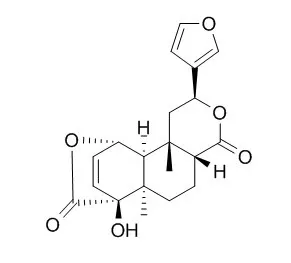| In vitro: |
| Eur J Pharmacol. 2012 Mar 5;678(1-3):61-70. | | In vitro and in vivo anti-inflammatory activities of columbin through the inhibition of cycloxygenase-2 and nitric oxide but not the suppression of NF-κB translocation.[Pubmed: 22227329] | Columbin, a diterpenoid furanolactone, was isolated purely for the first time from the plant species Tinspora bakis. The anti-inflammatory effects of Columbin were studied in vitro, in silico and in vivo.
METHODS AND RESULTS:
The effect of Columbin on nitric oxide was examined on lipopolysaccharide-interferon-gamma (LPS/IFN) induced RAW264.7 macrophages. In vitro and in silico cyclooxygenase-1 and cyclooxygenase-2 inhibitory activities of Columbin using biochemical kit and molecular docking, respectively, were investigated. Mechanism of Columbin in suppressing NF-kappaB-translocation was tested using Cellomics®NF-κB activation assay and ArrayScan Reader in LPS-stimulated RAW264.7 cells. Moreover, effects of Columbin in vivo that were done on carrageenan-induced mice paw-oedema were tested. Lastly, the in vitro and in vivo toxicities of Columbin were examined on human liver cells and mice, respectively. Treatment with Columbin or N(ω)-nitro-l-arginine methyl ester (l-NAME) inhibited LPS/IFN-γ-induced NO production without affecting the viability of RAW264.7. Pre-treatment of stimulated cells with Columbin did not inhibit the translocation of NF-κB to the nucleus in LPS-stimulated cells. COX-1 and COX-2 inhibitory activities of Columbin were 63.7±6.4% and 18.8±1.5% inhibition at 100μM, respectively. Molecular docking study further helped in supporting the observed COX-2 selectivity.
Whereby, the interaction of Columbin with Tyr385 and Arg120 signifies its higher activity in COX-2, as Tyr385 was reported to be involved in the abstraction of hydrogen from C-13 of arachidonate, and Arg120 is critical for high affinity arachidonate binding. Additionally, Columbin inhibited oedema formation in mice paw. Lastly, the compound was observed to be safe in vitro and in vivo.
CONCLUSIONS:
This study presents Columbin as a potential anti-inflammatory drug. | | J Enzyme Inhib Med Chem. 2005 Aug;20(4):365-8. | | Columbin inhibits cholesterol uptake in bloodstream forms of Trypanosoma brucei-A possible trypanocidal mechanism.[Pubmed: 16206831] | The diterpenoid furanolactone (columbin) from Aristolochia albida inhibited growth of culture forms of Trypanosoma brucei.
METHODS AND RESULTS:
In vitro analysis of the compound at 5-250 microg/ml showed complete lysis of the parasites within 10-20 minutes post incubation. At 50 microg/ml, Columbin killed about 50% of the parasites which initially appeared swollen under phase contrast microscopy. Also the total amount of cholesterol diminished dose-dependently in the presence of 10-100 microg/ml of Columbin after a 3-day incubation period.
CONCLUSIONS:
In vivo analysis of the compound in T. brucei-infected mice revealed that 25 mg/kg administered for 3 consecutive days, completely cleared the parasites from the peripheral circulation. However, Columbin could not clear parasites in the cerebrospinal fluid. | | Biomed Chromatogr. 2007 Jun;21(6):642-8. | | Quantitative LC/MS/MS method and pharmacokinetic studies of columbin, an anti-inflammation furanoditerpen isolated from Radix Tinosporae.[Pubmed: 17345572] | Columbin is an important component isolated from Radix Tinosporae. It has been demonstrated to possess many pharmacological activities, including anti-inflammation, antitumor and inhibition of enzyme activity in vivo.
METHODS AND RESULTS:
The purpose of the present study was to examine in vivo pharmacokinetics and bioavailability of Columbin in rats using a high-performance liquid chromatography coupled with tandem mass spectrometry quantitative detection method. The Columbin was extracted from rat plasma samples by methyl tert-butyl ether, evaporated and reconstituted in 100 microL methanol prior to analysis. The separation was performed using a Luna reversed-phase analytical column (5 microm, 100 x 2.0 mm) and an SB-C18 guard column (5 microm, 20 x 4.0 mm). The mobile phase was a mixture of methanol and water containing 25 mmoL/L NH(4)Ac (80:20, v/v). The method was validated within the concentration range of 5-5000 ng/mL, and the calibration curves were linear with correlation coefficients (r) >0.999. It was further applied to assess pharmacokinetics and oral bioavailability of Columbin after i.v. and oral administration to rats.
CONCLUSIONS:
The oral bioavailability of Columbin was only 3.18%, which indicated that Columbin had poor absorption or underwent extensive first-pass metabolism. |
|






 Cell. 2018 Jan 11;172(1-2):249-261.e12. doi: 10.1016/j.cell.2017.12.019.IF=36.216(2019)
Cell. 2018 Jan 11;172(1-2):249-261.e12. doi: 10.1016/j.cell.2017.12.019.IF=36.216(2019) Cell Metab. 2020 Mar 3;31(3):534-548.e5. doi: 10.1016/j.cmet.2020.01.002.IF=22.415(2019)
Cell Metab. 2020 Mar 3;31(3):534-548.e5. doi: 10.1016/j.cmet.2020.01.002.IF=22.415(2019) Mol Cell. 2017 Nov 16;68(4):673-685.e6. doi: 10.1016/j.molcel.2017.10.022.IF=14.548(2019)
Mol Cell. 2017 Nov 16;68(4):673-685.e6. doi: 10.1016/j.molcel.2017.10.022.IF=14.548(2019)